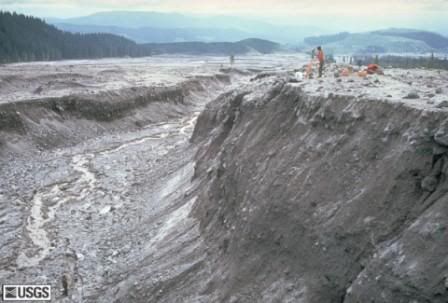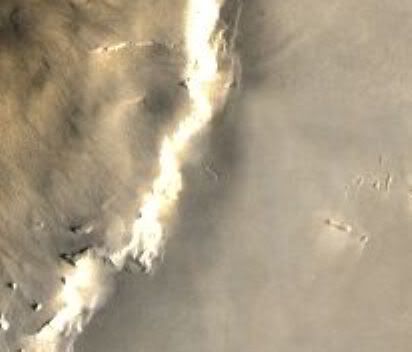- Thank you received: 0
T or E
19 years 3 weeks ago #10874
by rderosa
Replied by rderosa on topic Reply from Richard DeRosa
Here's an interesting one. This is the "T" from SP243004, cropped, with no image processing other than Histogram Equalize. It's very easy to see the walls without the light inversion effect, to see that this is a trench.
{Image deleted temporarily} SP243004_c1_HE50pct.jpg
rd
{Image deleted temporarily} SP243004_c1_HE50pct.jpg
rd
Please Log in or Create an account to join the conversation.
- neilderosa
-
- Offline
- Platinum Member
-

Less
More
- Thank you received: 0
19 years 3 weeks ago #10875
by neilderosa
Replied by neilderosa on topic Reply from Neil DeRosa
<i>Originally posted by jrich </i><blockquote id="quote"><font size="2" face="Verdana, Arial, Helvetica" id="quote">quote:<hr height="1" noshade id="quote">The fact that the slope angle appears to be uniform is probably not significant for determining artificiality, since any uniform granular material (like volcanic ash, as I propose) would behave in exactly this way. Also, this type of material would tend to smooth out any underlying irregularities in the substrate, making wall and floors appear much more regular. For those of you who have experienced major snowfall, the visual effect of volcanic ash on a landscape is very similar.<hr height="1" noshade id="quote"></blockquote id="quote"></font id="quote">
This struck me as reasonable since I was working nearby when Mt. St. Helen blew back in 1980. There was a layer of fine ash maybe an inch thick in some places, covering everything--like a grey snow cover.
I thought I'd take a look to see if there was anything to illustrate what JR was getting at. Here's a closeup of a nearby channel taken after the erruption:
vulcan.wr.usgs.gov/Volcanoes/MSH/Images/...ork.html#before_1980
vulcan.wr.usgs.gov/Imgs/Jpg/MSH/Images/M...ion_06-26-81_med.jpg
Though this is much more natural in appearence, even after the "levelling-out effect" from the ash of the MSH erruption, I still tend to agree with JR that sloped walls and flat bottoms are not in themselves sufficient to prove the artificiality of the T or E. Olympus Mons may have had a much larger erruption, and it's aftermath less disturbed than it would be on Earth by erosion. Maybe. But there is more to our hypothesis than that. Won't you help us get more and better imaging of this feature and area, if only to prove us wrong?
Neil
This struck me as reasonable since I was working nearby when Mt. St. Helen blew back in 1980. There was a layer of fine ash maybe an inch thick in some places, covering everything--like a grey snow cover.
I thought I'd take a look to see if there was anything to illustrate what JR was getting at. Here's a closeup of a nearby channel taken after the erruption:
vulcan.wr.usgs.gov/Volcanoes/MSH/Images/...ork.html#before_1980
vulcan.wr.usgs.gov/Imgs/Jpg/MSH/Images/M...ion_06-26-81_med.jpg
Though this is much more natural in appearence, even after the "levelling-out effect" from the ash of the MSH erruption, I still tend to agree with JR that sloped walls and flat bottoms are not in themselves sufficient to prove the artificiality of the T or E. Olympus Mons may have had a much larger erruption, and it's aftermath less disturbed than it would be on Earth by erosion. Maybe. But there is more to our hypothesis than that. Won't you help us get more and better imaging of this feature and area, if only to prove us wrong?
Neil
Please Log in or Create an account to join the conversation.
19 years 3 weeks ago #10876
by Gregg
Replied by Gregg on topic Reply from Gregg Wilson
Ash fall or "snow" fall would perhaps hide tertiary geometric irregularities and "blend" secondary geometric irregularities, but it would not transform a curved trench into a straight trench. The primary geometry of the "T or E" remains, imho, artificial.
Gregg Wilson
Gregg Wilson
Please Log in or Create an account to join the conversation.
- neilderosa
-
- Offline
- Platinum Member
-

Less
More
- Thank you received: 0
19 years 3 weeks ago #10877
by neilderosa
Replied by neilderosa on topic Reply from Neil DeRosa
"Ash fall or "snow" fall would perhaps hide tertiary geometric irregularities and "blend" secondary geometric irregularities, but it would not transform a curved trench into a straight trench. The primary geometry of the "T or E" remains, imho, artificial." [Gregg]
Precisely. The Mt. St. Helen related image was taken several months after the erruption. The inch or so of new ash that I saw the day after the erruption (it was spread out over hundreds of square miles that I know of, by the way) would not have made natural looking channels look artificial. It would probably take an ash layer of several feet thick, undisturbed by erosion, to make sloped walls and flat bottoms. And even that much ash couldn't straighten out the trench or cross it with Tees. I was just trying to give the benifit of the doubt, in the interest of fairness.
Neil
Precisely. The Mt. St. Helen related image was taken several months after the erruption. The inch or so of new ash that I saw the day after the erruption (it was spread out over hundreds of square miles that I know of, by the way) would not have made natural looking channels look artificial. It would probably take an ash layer of several feet thick, undisturbed by erosion, to make sloped walls and flat bottoms. And even that much ash couldn't straighten out the trench or cross it with Tees. I was just trying to give the benifit of the doubt, in the interest of fairness.
Neil
Please Log in or Create an account to join the conversation.
19 years 3 weeks ago #10878
by jrich
Replied by jrich on topic Reply from
Neil,
In some of the images of the T and other channels you can see layering in the walls that is very similar to that visible in the Mt. St. Helens channel picture you posted. I don't think its conclusive, but believe it would be reasonable to assume that the material in which the channels are cut is volcanic ash or a close Martian analog. Do we have any information about when Olympus Mons was last active relative to the presumed EPH event that destroyed the parent planet and did so much violence to Mars?
JR
In some of the images of the T and other channels you can see layering in the walls that is very similar to that visible in the Mt. St. Helens channel picture you posted. I don't think its conclusive, but believe it would be reasonable to assume that the material in which the channels are cut is volcanic ash or a close Martian analog. Do we have any information about when Olympus Mons was last active relative to the presumed EPH event that destroyed the parent planet and did so much violence to Mars?
JR
Please Log in or Create an account to join the conversation.
- neilderosa
-
- Offline
- Platinum Member
-

Less
More
- Thank you received: 0
19 years 3 weeks ago #10879
by neilderosa
Replied by neilderosa on topic Reply from Neil DeRosa
<i>Originally posted by jrich </i><blockquote id="quote"><font size="2" face="Verdana, Arial, Helvetica" id="quote">quote:<hr height="1" noshade id="quote">Do we have any information about when Olympus Mons was last active relative to the presumed EPH event that destroyed the parent planet and did so much violence to Mars?
<hr height="1" noshade id="quote"></blockquote id="quote"></font id="quote">
That's a good question to save for Tom when he returns. I have little doubt that the mainstream model and EPH will differ on what caused the most recent period of active volcanism of Olympus Mons and other mountains on Mars, and when. Here's an image of OM. Interestingly, in the uncompressed (3.3mb) Viking color mosaic accessible through the link, (cropping seen below), you can zoom in on the T or E feature (in the SE or lower right corner) and see it almost as well as in the MOC context images. Also interesting is that this mosaic reflects morning shadows (Sun coming from the east) as does the original T image (SP243004). All of the context images of the T or E that I know of have the Sun coming from the west.
nssdc.gsfc.nasa.gov/image/planetary/mars/olympus_mons.jpg
Neil
<hr height="1" noshade id="quote"></blockquote id="quote"></font id="quote">
That's a good question to save for Tom when he returns. I have little doubt that the mainstream model and EPH will differ on what caused the most recent period of active volcanism of Olympus Mons and other mountains on Mars, and when. Here's an image of OM. Interestingly, in the uncompressed (3.3mb) Viking color mosaic accessible through the link, (cropping seen below), you can zoom in on the T or E feature (in the SE or lower right corner) and see it almost as well as in the MOC context images. Also interesting is that this mosaic reflects morning shadows (Sun coming from the east) as does the original T image (SP243004). All of the context images of the T or E that I know of have the Sun coming from the west.
nssdc.gsfc.nasa.gov/image/planetary/mars/olympus_mons.jpg
Neil
Please Log in or Create an account to join the conversation.
Time to create page: 0.383 seconds



